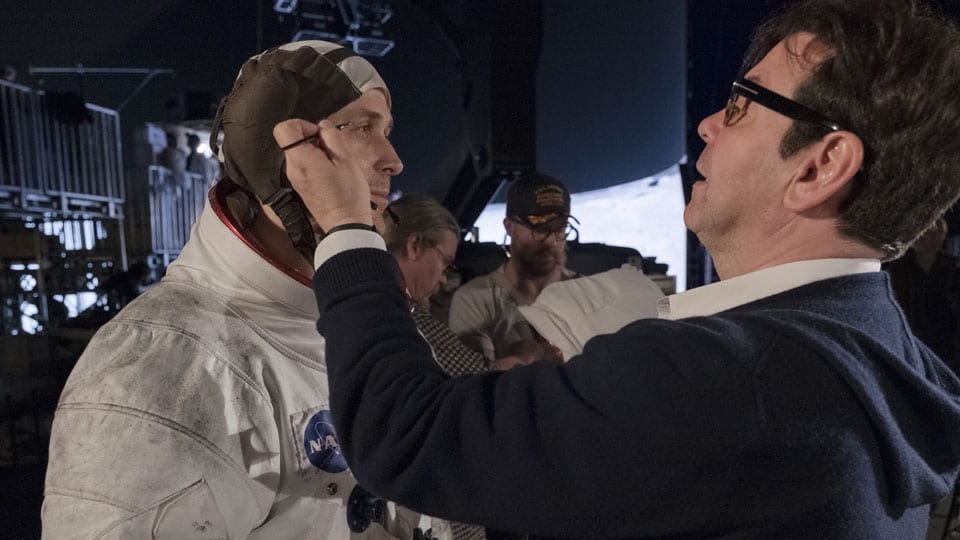
Director, Kathryn Bigelow called cinematographer, Barry Ackroyd, in the spring of 2007. She had seen United 93, which he had shot, and wanted The Hurt Locker to have the same “visceral look and immediacy of that film.” Their first face-to-face meeting was in Jordan during prep in preproduction. “We discussed films, but I always feel that understanding the gist of the story will lead to the style,” shares Ackroyd. “The thing about The Hurt Locker is that it has such a strong script. It became clear that the filming would be the way it is.”
During the course of production, over 1 million feet of film was shot using four main cameras. A Phantom Digital camera was used to capture the slo-mo shots that punctuate the film and a mini S16mm camera (Aaton Minima) was used for hidden shots. “Right from our fist conversation I had suggested that Super 16 mm cameras would be the best option. I had recently shot Battle in Seattle this way. I wanted to retain the Canadian crew from that shoot, so besides my favored crew from UK, we added local talent, loaders from North Africa, and camera-operators from Canada, Iraq and Denmark – all people who had documentary experience,” said Ackroyd. “I also recommended Ray Becket as sound recordist. Ray I have worked together dozens of times and I know he can get great sound in difficult conditions. My gaffer, Matt Moffatt, came over from London, but we used all local electricians and grips from Jordan and Lebanon.”
The film was shot in Jordan where military hardware, Humvees and other supplies were at hand. “It’s hard to remember now, all the tough stuff we had to go through while in Jordan. In fact my overall impression was of a smooth and enjoyable shoot. But I know it wasn’t all like that. The summer temperatures were formidable. The schedule was tough, but the morale was good. We had a great crew and fantastic cast to work with,” says Ackroyd. “I say all this now, but others would say it was just tough. Each day was a challenge. We had the brief to get as close as we could to the action. Covering the physical as well as the emotional journey that our story demanded. For me it’s important to intuit the next move, not to know too much. So this involved staging huge scenes, often over several city blocks and filming continuous takes with multiple cameras. I feel that it’s this struggle that gives the film its feel.”
As for the triumphs, Ackroyd’s personal favorite was the “Bomb Factory” scene set in the disused chocolate factory, where Sgt. James retrieves the “body bomb.” He explains, “We spent two or three days traversing the building, shooting in sequence and treading carefully through the scene, building up tension. When the body is discovered, our plan was to use reflected light, bounce off mirrors through the windows. It worked great. It gave the scene an intensity that shows the heat and the terrible feeling of exposure that the Bomb Squads experience. It shows the danger and the dedication, of the OED team’s work.”
Previous Noms and Wins
2010: Nominated, Critics Choice Awards, Best Cinematography, The Hurt Locker; Nominated, Online Film Critics Society Award, Best Cinematography, The Hurt Locker. 2009: Won, Austin Film Critics Award, Best Cinematography, The Hurt Locker; Won, Boston Society of Film Critics Award, Best Cinematography, The Hurt Locker; Won, Chicago Film Critics Association Award, Best Cinematography, The Hurt Locker; Won, Las Vegas Film Critics Society Sierra Award, Best Cinematography, The Hurt Locker. 2008: Nominated, Camerimage Golden Frog, The Hurt Locker. 2007: Nominated, BAFTA Film Award, Best Cinematography, United 93; 2006: Nominated, British Independent Film Award, Best Technical Achievement, The Wind That Shakes the Barley; Won, European Film Award, Best Cinematography, The Wind That Shakes the Barley. 2004: Nominated, BAFTA TV Award, Best Photography and Lighting (Fiction/Entertainment) The Lost Prince (TV). 2003: Won, Brothers Manaki International Film Festival, Golden Camera 300, Sweet Sixteen. 2002: Won, Camerimage Special Award, Best Duo: Director-Cinematographer; Nominated, Camerimage Golden Frog, Sweet Sixteen; Won, Valladolid International Film Festival, Best Director of Photography. Sweet Sixteen. 1997: Nominated, BAFTA Film Award, Best Short Film, The Butterfly Man; Nominated, Molodist International Film Festival, Best Film Award, Best Short Fiction Film, The Butterfly Man; 1996: Nominated, Camerimage Golden Frog, Carla’s Song.






[…] During the course of production, over 1 million feet of film was shot using four main cameras. A Phantom digital high-speed camera was used to capture the slow-motion shots that punctuate the film. Continue reading […]
[…] shoots more frames per second than you ever thought imaginable, giving insane detail in slow-mo. It was also used in “The Hurt Locker” to get detail from the intense slow motion […]